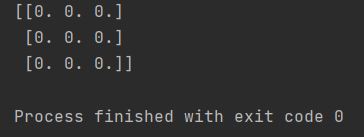Let’s see how to create empty array in Numpy Python module.

How to Create Empty Arrays with NumPy
The np.empty does not initialize the array elements to zero or any other specific value. Instead, it allocates memory for the array and leaves the existing values in that memory as they are. These values will be whatever was present in those memory locations previously, which could be seemingly random or depend on the state of your system’s memory.
np.empty((3, 3)) creates an empty array in NumPy by allocating memory without initializing values—the contents will be whatever data was previously in that memory location, not zeros.
import numpy as np empty_array = np.empty((3, 3)) print(empty_array)
Therefore, when you print an array created with np.empty, you will likely see seemingly arbitrary numbers. These are not empty values in the sense of being null or missing, but rather pre-existing data in the allocated memory that NumPy has not overwritten.
How to create empty array in Numpy?
To create an empty array in Numpy, you can use the following steps:
1. Import the numpy module.
2. Use the empty() function from the numpy module to create an empty array.
3. Specify the shape of the empty array.
4. Print the empty array.
Due to its uninitialized nature, np.empty is generally faster than np.zeros or np.ones when creating large arrays, as it skips the step of setting initial values. However, it’s crucial to be aware that you should always explicitly assign values to the elements of an array created with np.empty before using it in computations. Otherwise, you may encounter unpredictable or incorrect results due to operating on these uninitialized values.
When should you use np.empty? It is most appropriate in situations where you intend to fill the array with data immediately after creation. For example, if you are about to perform a calculation that will overwrite all elements of the array anyway, using np.empty can offer a slight performance advantage. However, for most common scenarios, especially when learning NumPy or when data integrity is paramount, using np.zeros or np.ones to create arrays with known initial values is often a safer and more predictable practice.
